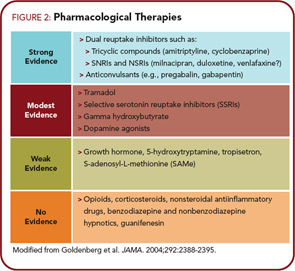The arrows on Figure 1 indicate the direction of the abnormalities in these neurotransmitter levels, either in the cerebrospinal fluid (CSF) or brain, that have been identified to date in FM. In FM, there is evidence for increases in the CSF levels of substance P, glutamate, nerve growth factor, and brain derived neurotrophic factor, and low levels of the metabolites of serotonin, norepinephrine, and dopamine, any of which could lead to an increase in the volume control and augmented pain and sensory processing.30-33 The only neurotransmitter system that has been studied to date and not found to be out of line in a direction that would cause augmented pain transmission is the endogenous opioid system. Both CSF levels and brain activity by functional neuroimaging appear to be augmented, not reduced (as would cause augmented pain processing) in FM, which may be why opioidergic drugs do not work well to treat FM and related pain syndromes.34,35
Potential Role of Cytokines
Although the CSS conditions all were originally felt to be autoimmune or inflammatory diseases and then later felt not to be, recent findings are leading to a reconsideration of whether subtle inflammatory changes may be responsible for some of the symptoms seen. Immunological cascades have a role in the maintenance of central sensitivity and chronic pain which is enhanced through release of proinflammatory cytokines by CNS glial cells; thus, the traditional paradigm regarding inflammatory versus noninflammatory pain may gradually become less dichotomic. As may be expected in any complex biological system, a delicate apparatus of checks and balances is at work in the spinal transmission of pain. Multiple inhibitory transmitters act at the spinal level to reduce the volume of pain transmission. Serotonin, norepinephrine, enkephalins, dopamine, and gamma-aminobutyric acid (GABA) are among the better known players in this balance.36
Similar Treatments for Many CSS Entities
Several drug and nondrug therapies have been shown to be effective for most of the CSS disorders, further reinforcing that this may be a large overlapping disorder rather than several separate ones. Among classes of drugs, substantial data suggest that tricyclic compounds are effective for treating most of the conditions noted.37-39 Newer serotonin–norep – inephrine reuptake inhibitors such as duloxetine and tramadol have similarly been shown to be effective across a broad range of these conditions.40 Interestingly, duloxetine had much earlier been shown to be helpful in treating the pain associated with depression, which is not surprising. The alpha-2- delta ligands, such as pregabalin and gabapentin, are also being shown to be efficacious in a wide range of these entities.41
